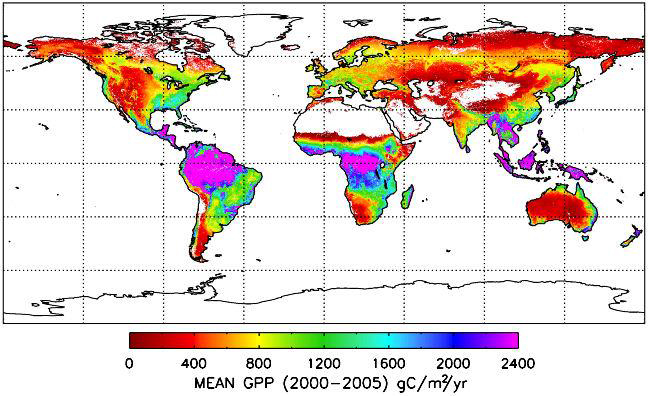Context and objectives
Gross primary productivity (GPP) is possibly one of the most important ecosystem services made to society. While global products of GPP from remote sensing (e.g. MOD17) and land surface models do capture the global patterns, they still fail to capture the existing huge variability within biomes. The ECOPROPHET project aimed to improve GPP global estimates by testing to what degree the multitude of new Earth Observation products (e.g. from Sentinel-2 and SIF products) are better proxies of ecosystem functional phenology (photosynthetic activity) and by re-parameterizing the phenology modules of land Surface models.
Project outcome
Scientific results
Vegetation indices derived from Sentinel-2 images can be suitable descriptors of the GPP phenology. Among all investigated vegetation indices, chlorophyll-sensitive indices showed the best fit with the ecosystem productivity in a poplar plantation (Maleki et al., 2020) and captured quite well the onset of senescence in beech, oak and birch (Marien et al., 2019).
At local scale we found that all VIs failed in describing GPP during an extreme drought event. After integrating a drought indicator (e.g., soil water content, precipitation/potential evapotranspiration ratio or actual/potential evapotranspiration ratio) in the regression model, the performances of VIs drastically improved (Maleki et al., 2022, accepted for publication in Agriculture Forest Meteorology).
In the land surface models, it was found that the errors in the surface fluxes were strongly correlated to errors in LAI. The simulated phenological cycle in ISBA and ORCHIDEE was delayed compared to observations, and failed to capture the observed seasonal variability. The feedback mechanism between GPP and LAI (i.e. the biomass allocation scheme) was identified as a key element to improve the intricate coupling between energy, water and vegetation in land surface models (De Pue et al., in revision in BG).
The carbon uptake phenology was improved in the ORCHIDEE model over the Amazonian rainforest. The leaves demography was modified at the beginning of the dry season, with both an increase of shedding of old leaves and an increase of allocation of carbon towards young leaves, which are more photosynthetically efficient. The consecutive improvement of the simulated GPP seasonal cycle was demonstrated against observations, both at site and regional scales. Using radiation or vapour pressure deficit as the environmental driver for leaf shedding and leaf flush gave equivalent results.
Results of the comparison of between land surface models and RS-based linear model developed in the framework of the project showed a fair correlation between the anomalies in the leaf phenology (quantified by LAI and the VI) and the in situ carbon uptake phenology, when excluding the evergreen sites. In this case, the stronger correlation is found in LAI, compared to NDVI, EVI and NIRv. Notably, a poorer relation was found for maximum of season, compared to the start and end of season. SIF does not rely on the greenness of the vegetation, but is a proxy for the photosynthetic activity. Consequently, a good relation was found between in situ GPP and SIF phenology for both evergreen and non-evergreen plant functional types. No such relation was found for LAI, NDVI, EVI or NIRv. These results were presented at the IGARSS 2021 conference, and form the basis for the joint paper that is in the preparation in the frame of the ECOPROPHECIES DISSUP project.
Societal (including environmental) relevance
The ECOPROPHET project provided new important insights on the modelling of GPP which were shared with stakeholders from other modelling teams. Presentations, workshops and seminars were held for the ACCORD surface consortium, the ISBA development team at CNRM, and the ORCHIDEE developers.
Products and services
Data and products produced in the framework of the project are available under request to project PIs.
Potential users
Research centres, meteorological institutes, environmental agencies.
Outreach
ECOPROPHET : Quantifying the productivity of continental ecosystems
ECOPROPHET: Kwantificering van de productiviteit van continentale ecosystemen
ECOPROPHET : Quantifier la productivité des écosystèmes continentaux
| Project leader(s): | UA - Plants and Ecosystems (PLECO) | |||||
| Belgian partner(s) |
|
|||||
| International partner(s) |
|
|||||
| Location: |
Global Region:
|
|||||
| Related presentations: | ||||||
| Website: | http://ecoprophet.meteo.be | |||||
